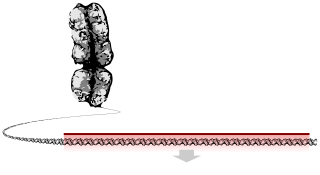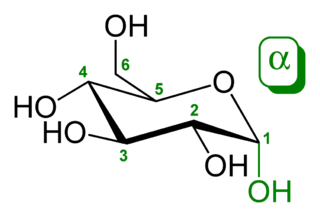
Cotransporters are a subcategory of membrane transport proteins (transporters) that couple the favorable movement of one molecule with its concentration gradient and unfavorable movement of another molecule against its concentration gradient. They enable cotransport and include antiporters and symporters. In general, cotransporters consist of two out of the three classes of integral membrane proteins known as transporters that move molecules and ions across biomembranes. Uniporters are also transporters but move only one type of molecule down its concentration gradient and are not classified as cotransporters.
Glycosuria is the excretion of glucose into the urine. Ordinarily, urine contains no glucose because the kidneys are able to reabsorb all of the filtered glucose from the tubular fluid back into the bloodstream. Glycosuria is nearly always caused by elevated blood glucose levels, most commonly due to untreated diabetes mellitus. Rarely, glycosuria is due to an intrinsic problem with glucose reabsorption within the kidneys, producing a condition termed renal glycosuria. Glycosuria leads to excessive water loss into the urine with resultant dehydration, a process called osmotic diuresis.

The sodium-chloride symporter (also known as Na+-Cl− cotransporter, NCC or NCCT, or as the thiazide-sensitive Na+-Cl− cotransporter or TSC) is a cotransporter in the kidney which has the function of reabsorbing sodium and chloride ions from the tubular fluid into the cells of the distal convoluted tubule of the nephron. It is a member of the SLC12 cotransporter family of electroneutral cation-coupled chloride cotransporters. In humans, it is encoded by the gene SLC12A3 (solute carrier family 12 member 3) located in 16q13.

Glucose-galactose malabsorption is a rare condition in which the cells lining the intestine cannot take in the sugars glucose and galactose, which prevents proper digestion of these molecules and larger molecules made from them.

Sodium/glucose cotransporter 1 also known as solute carrier family 5 member 1 is a protein that in humans is encoded by the SLC5A1 gene.

Electrogenic sodium bicarbonate cotransporter 1 is a membrane transport protein that in humans is encoded by the SLC4A4 gene.
Renal glucose reabsorption is the part of kidney (renal) physiology that deals with the retrieval of filtered glucose, preventing it from disappearing from the body through the urine.

Sodium-dependent phosphate transport protein 1 is a protein that in humans is encoded by the SLC17A1 gene.

Solute carrier family 13 member 2 is a protein that is encoded in humans by the SLC13A2 gene.

Electrogenic sodium bicarbonate cotransporter 4 is a protein that in humans is encoded by the SLC4A5 gene.

Sodium-dependent phosphate transport protein 2C is a protein that in humans is encoded by the SLC34A3 gene.

Sergliflozin etabonate is an investigational anti-diabetic drug being developed by GlaxoSmithKline. It did not undergo further development after phase II.

Canagliflozin is a medication used for the treatment of type 2 diabetes. It is of the gliflozin class or subtype 2 sodium-glucose transport (SGLT-2) inhibitors class.

The low affinity sodium-glucose cotransporter also known as the sodium/glucose cotransporter 3 (SGLT3) or solute carrier family 5 member 4 (SLC5A4) is a protein that in humans is encoded by the SLC5A4 gene.

Sodium-coupled neutral amino acid transporter 10 also known as solute carrier family 38, member 10 is a protein that in humans is encoded by the SLC38A10 gene.
Empagliflozin, sold under the trade name Jardiance among others, is a medication used together with diet and exercise for the treatment of type 2 diabetes. It may be used together with metformin or insulin. It is not useful for type 1 diabetes. It is taken by mouth.

Tofogliflozin is an experimental drug for the treatment of diabetes mellitus and is being developed by Chugai Pharma in collaboration with Kowa and Sanofi. It is an inhibitor of subtype 2 sodium-glucose transport protein (SGLT2), which is responsible for at least 90% of the glucose reabsorption in the kidney. As of September 2012, the drug is in Phase III clinical trials.
Gliflozins are a class of drugs in the treatment of type 2 diabetes (T2D). They act by inhibiting sodium/glucose cotransporter 2 (SGLT-2), and are therefore also called SGLT-2 inhibitors. The efficacy of the drug is dependent on renal excretion and prevents glucose from going into blood circulation by promoting glucosuria. The mechanism of action is insulin independent.
Gliflozin drugs are a class of medications that inhibit reabsorption of glucose in the kidney and therefore lower blood sugar. They act by inhibiting sodium-glucose transport protein 2 (SGLT2), and are therefore also called SGLT2 inhibitors. Gliflozins are used in the treatment of type II diabetes mellitus (T2DM). Apart from glycemic control, gliflozins have been shown to provide significant cardiovascular benefit in T2DM patients. Several drugs of this class have been approved or are currently under development. In studies on canagliflozin, a member of this class, the drug was found to enhance blood sugar control as well as reduce body weight and systolic and diastolic blood pressure.





















